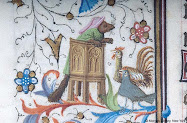The costume thing has become a distinctive feature of the Wellington event. It started with a few groups of hardcore fans dressing up the first year, but now literally thousands of people dress up - perhaps as an unspoken alternative to the fun of Halloween, which we don’t really do in this country. The costumes seem to get more spectacular every year, and often show a good deal of creativity, planning and effort. This year’s offerings included a bunch of guys dressed as the components of a sandwich (two slices of bread, ham, tomato, cheese and an egg), and a massive bunch who came dressed as the 101 Dalmatians (yes, there were actually 101 of them).
What always fascinates me, though, is the number of guys for whom getting into costume is license to get into drag. This certainly taps into the carnivalesque nature of the event, as it creates an opening for symbolic transgression of gender roles and social order. I’m sure the guys heading to the rugby in their mini skirts and high heels weren’t thinking about this, but it’s fascinating to consider them as modern actors in a very old communal play. This form of ritualised inversion helps social groups ‘let off steam’ by symbolically testing the limits of communal values without actually breaking those barriers. In sixteenth century France, these young men might have dressed as kings or bishops, using parody of their ‘betters’ to offer a ritualised challenge to rigid social and political hierarchies. In modern Western societies - particularly one like New Zealand, where class boundaries are quite blurred and permeable - gender remains as a very visible stratifying system by which our social roles and behaviour get ordered.
It’s interesting that in this society, at least, a woman dressing like a man is no longer considered transgressive at all (except, perhaps, by my mother). In fact, according to the doyennes of fashion in New York and Paris, every few years it becomes positively the height of style. But going the other way is still taboo except in circumstances like the sevens tournament or fancy dress parties. I’m no sociologist but I’m sure there is a hugely complex web of factors contributing to this state. As a medievalist, though, I'm prompted to speculate about the notion from Aristotelian natural philosophy that things can move from a state of lesser to greater perfection (in medieval terms, from female to male) but not the other way around. Thus, female saints cross-dressing as males became a pretty standard trope in medieval hagiography. In these narratives, when a woman dressed as a man and, by implication, took on manly virtues, it became one sign of sanctity. But I can’t think of any examples going the other way, nor can I imagine that given the general medieval worldview on gender and natural order, a cross-dressed man could have been seen as anything other than dangerously transgressive. Anyone know of any examples to the contrary?
Here’s my favourite Sevens costume (entirely gender-neutral, unless you consider filling the chilly bin with beer is a man’s job) -




